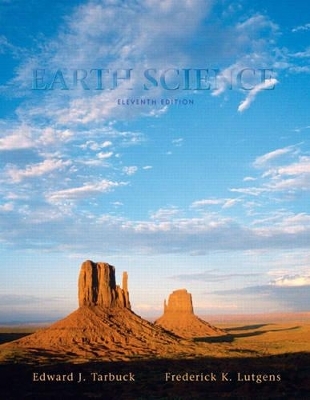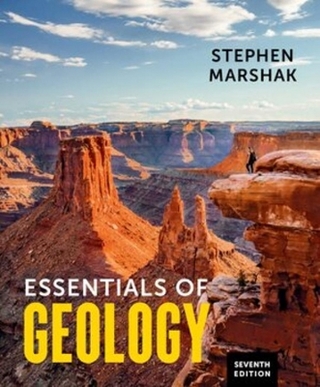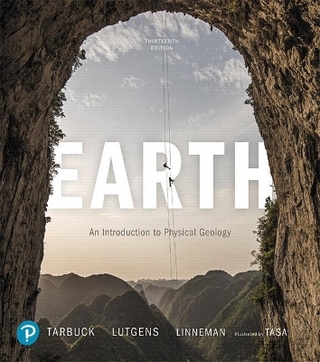
Earth Science
Pearson
978-0-13-149751-1 (ISBN)
- Titel erscheint in neuer Auflage
- Artikel merken
The eleventh edition of Earth Science offers a user-friendly overview of our physical environment with balanced, up-to-date coverage of geology, oceanography, astronomy, and meteorology for the undergraduate student with little background in science. The emphasis is on readability, with clear example-driven explanations. The eleventh edition takes full advantage of the subject’s visual appeal, with discussions reinforced by incredible color photos and superb illustrations by Earth science illustrator Dennis Tasa.
1. Introduction to Earth Science
What Is Earth Science?
Earth Science, People, and the Environment
The Nature of Scientific Inquiry
Scales of Space and Time in Earth Science
Early Evolution of Earth’s Spheres
A Closer Look at the Geosphere
Earth As a System
Box 1.1 Earth As a System: Earth’s Place in the Cosmos
Box 1.2 Understanding Earth: Studying Earth from Space
UNIT 1: EARTH MATERIALS
2. Minerals: Building Blocks of Rocks
Minerals: The Building Blocks of Rocks
Elements: The Building Blocks of Minerals
Why Atoms Bond
Properties of Minerals
Mineral Groups
Mineral Resources
Box 2.1 People and the Environment: Making Glass from Minerals
Box 2.2 Understanding Earth: Gemstones
3. Rocks: Materials of the Solid Earth
Earth As a System: The Rock Cycle
Igneous Rocks: “Formed by Fire”
Sedimentary Rocks: Compacted and Cemented Sediment
Metamorphic Rocks: New Rock from Old
Resources from Rocks and Minerals
Box 3.1 Earth As a System: The Carbon Cycle and Sedimentary Rocks
Box 3.2 People and the Environment: United States Per Capita Use of Mineral and Energy Resources
UNIT 2: SCULPTURING EARTH’S SURFACE
4. Weathering, Soil, and Mass Wasting
Earth’s External Processes
Weathering
Mechanical Weathering
Chemical Weathering
Rates of Weathering
Soil
Controls of Soil Formation
The Soil Profile
Classifying Soils
Soil Erosion
Weathering Creates Ore Deposits
Mass Wasting: The Work of Gravity
Mass Wasting and Landform Development
Controls and Triggers of Mass Wasting
Classifying Mass-Wasting Processes
Slump
Rockslide
Debris Flow
Earthflow
Slow Movements
Box 4.1 Understanding Earth: The Old Man of the Mountain
Box 4.2 People and the Environment: Debris Flows on Alluvial Fans: A Case Study
from Venezuela
5: Running Water and Groundwater Earth as a System: The Hydrologic Cycle
Running Water
Streamflow
The Work of Running Water
Stream Channels
Base Level and Stream Erosion
Shaping Stream Valleys
Depositional Landforms
Drainage Patterns
Floods and Flood Control
Groundwater: Water Beneath the Surface
Distribution and Movement of Groundwater
Groundwater
Springs
Wells
Artesian Wells
Environmental Problems Associated with Groundwater
The Geologic Work of Groundwater
Box 5.1 People and the Environment: Flash Floods
Box 5.2 Understanding Earth: Measuring Groundwater Movement
Box 5.3 People and the Environment: The Case of the Disappearing Lake
6. Glaciers, Deserts, and Wind
Glaciers: A Part of Two Basic Cycles in the Earth System How Glaciers Move
Glacial Erosion
Glacial Deposits
Glaciers of the Ice Age
Some Indirect Effects of Ice Age Glaciers
Causes of Glaciation
Deserts
Geologic Processes in Arid Climates
Basin and Range: The Evolution of a Desert Landscape
Wind Erosion
Wind Deposits
Box 6.1 Understanding Earth: Glacial Ice–A Storehouse of Climate Data
Box 6.2 People and the Environment: The Disappearing Aral Sea
UNIT 3: FORCES WITHIN
7. Earthquakes and Earth’s Interior
What Is an Earthquake?
San Andreas Fault: An Active Earthquake Zone
Seismology: The Study of Earthquake Waves
Locating an Earthquake
Measuring the Size of Earthquakes
Destruction from Earthquakes
Can Earthquakes Be Predicted?
Earth’s Layered Structure
Box 7.1 People and the Environment: Damaging Earthquakes East of the Rockies
Box 7.2 Understanding Earth: Inge Lehmann: A Pioneering Seismologist
8. Plate Tectonics: A Scientific Theory Unfolds
Continental Drift: An Idea Before Its Time
The Great Debate
Plate Tectonics: The New Paradigm
Divergent Boundaries
Convergent Boundaries
Transform Fault Boundaries
Testing the Plate Tectonics Model
Measuring Plate Motion
What Drives Plate Motion?
Plate Tectonics into the Future
Box 8.1 Understanding Earth: The Breakup of Pangaea
Box 8.2 Understanding Earth: Susan DeBari–A Career in Geology
9. Volcanoes and Other Igneous Activity
The Nature of Volcanic Eruptions
What Is Extruded During Eruptions?
Volcanic Structures and Eruptive Styles
Living in the Shadow of a Composite Cone
Other Volcanic Landforms
Intrusive Igneous Activity
Origin of Magma
Plate Tectonics and Igneous Activity
Box 9.1 People and the Environment: Eruption of Vesuvius a.d. 79
Box 9.2 Earth As a System: Can Volcanoes Change Earth’s Climate?
10. Mountain Building
Rock Deformation
Folds
Faults
Joints
Mountain Building
Mountain Building at Subduction Zones
Collisional Mountain Ranges
Fault-Block Mountains
Vertical Movements of the Crust
Box 10.1 People and the Environment: The San Andreas Fault System
UNIT 4: DECIPHERING EARTH’S HISTORY
11. Geologic Time
Geology Needs a Time Scale
A Brief History of Geology
Relative Dating–Key Principles
Correlation of Rock Layers
Fossils: Evidence of Past Life
Dating with Radioactivity
The Geologic Time Scale
Difficulties in Dating the Geologic Time Scale
Box 11.1 Understanding Earth: Deciphering the Past by Understanding the Present
Box 11.2 People and the Environment: Radon–A Threat to Human Health
Box 11.3 Understanding Earth: Using Tree Rings to Date and Study the Recent Past
12. Earth’s History: A Brief Summary
Precambrian Time: Vast and Enigmatic
Paleozoic Era: Life Explodes
Mesozoic Era: Age of the Dinosaurs
Cenozoic Era: Age of Mammals
Box 12.1 Understanding Earth: The Burgess Shale
Box 12.2 Earth As a System: Demise of the Dinosaurs
UNIT 5: THE GLOBAL OCEAN
13. The Ocean Floor
The Vast World Ocean
An Emerging Picture of the Ocean Floor
Continental Margins
The Ocean Basin Floor
The Oceanic Ridge
Seafloor Sediments
Resources from the Seafloor
Box 13.1 Understanding Earth: A Grand Break–Evidence for Turbidity Currents
Box 13.2 Understanding Earth: Explaining Coral Atolls–Darwin’s Hypothesis
Box 13.3 Understanding Earth: Collecting Geologic History from the Deep-Ocean Floor
14. Ocean Water and Ocean Life
Composition of Seawater
Ocean Temperature Variation
Ocean Density Variation
The Diversity of Ocean Life
Oceanic Productivity
Oceanic Feeding Relationships
Box 14.1 People and the Environment: Desalination of Seawater–Fresh Water from the Sea
Box 14.2 Earth As a System: Deep-Sea Hydrothermal Vent Biocommunities–Earth’s First Life?
Box 14.3 People and the Environment: The Iron Hypothesis–Fertilizing the Ocean to Reduce Global Warming
15. The Dynamic Ocean
Surface Circulation
Deep-Ocean Circulation
The Shoreline: A Dynamic Interface
The Coastal Zone
Waves
Wave Erosion
Sand Movement on the Beach
Shoreline Features
Stabilizing the Shore
Coastal Classification
Tides
Box 15.1 Understanding Earth: Running Shoes as Drift Meters–Just Do It
Box 15.2 People and the Environment: The Move of the Century–Relocating the Cape Hatteras Lighthouse
16 The Atmosphere: Composition, Structure, and Temperature
Weather and Climate
Composition of the Atmosphere
Height and Structure of the Atmosphere
Earth—Sun Relationships
Energy, Heat and Temperature
Mechanisms of Heat Transfer
The Fate of Incoming Solar Radiation
Heating the Atmosphere: The Greenhouse Effect
For the Record: Air Temperature Data
Why Temperatures Vary: The Controls of Temperature
World Distribution of Temperature
Box 16.1 People and the Environment: Altering the Atmosphere’s Composition–Sources and Types of Air Pollution
Box 16.2 People and the Environment: Ozone Depletion–A Global Issue
Box 16.3 Understanding Earth: Blue Skies and Red Sunsets
17 Moisture, Clouds, and Precipitation Water’s Changes of State
Humidity: Water Vapor in the Atmosphere
The Basis of Cloud Formation: Adiabatic Cooling
Processes that Lift Air
The Weathermaker: Atmospheric Stability
Condensation and Cloud Formation
Fog
How Precipitation Forms
Coalescence Process
Forms of Precipitation
Measuring Precipitation
Box 17.1 People and the Environment: Atmospheric Stability and Air Pollution
Box 17.2 Understanding Earth: Science and Serendipity
18. Air Pressure and Wind Understanding Air Pressure
Measuring Air Pressure
Factors Affecting Wind
Highs and Lows
General Circulation of the Atmosphere
The Westerlies
Local Winds
How Wind Is Measured
El Nino and La Nina (Please insert tildes over “n”s)
Global Distribution of Precipitation
Box 18.1 People and the Environment: Wind Energy–An Alternative with Potential
Box 18.2 Understanding Earth: Monitoring Ocean Winds from Space
19. Weather Patterns and Severe Storms
Air Masses
Fronts
The Middle-Latitude Cyclone
What’s In a Name?
Thunderstorms
Tornadoes
Hurricanes
Box 19.1 Understanding Earth: A Brief Overview of the Weather Business
Box 19.2 People and the Environment: Lightning Safety
20. Climate
The Climate System
World Climates
Climate Classification
Humid Tropical (A) Climates
Dry (B) Climates
Humid Middle-Latitude Climates with Mild Winters (C Climates)
Humid Middle-Latitude Climates with Severe Winters (D Climates)
Polar (E) Climates
Highland Climates
Human Impact on Global Climate
Carbon Dioxide, Trace Gases, and Global Warming
Climate-Feedback Mechanisms
How Aerosols Influence Climate
Some Possible Consequences of Global Warming
Box 20.1 Understanding Earth: Computer Models of Climate: Important Yet Imperfect Tools
UNIT 7: EARTH’S PLACE IN THE UNIVERSE
21. Origin of Modern Astronomy
Ancient Astronomy
The Birth of Modern Astronomy
Constellations
Positions in the Sky
Motions of Earth
Motions of the Earth-Moon System
Box 21.1 Understanding Earth: Foucault’s Experiment
Box 21.2 Understanding Earth: Astrology–The Forerunner of Astronomy
22. Touring Our Solar System
The Planets: An Overview
Earth’s Moon
The Planets: A Brief Tour
Minor Members of the Solar System
Box 22.1 Understanding Earth: Pathfinder–The First Geologist on Mars
Box 22.2 Earth As a System: Is Earth on a Collision Course?
23. Light, Astronomical Observations, and the Sun
The Study of Light
Astronomical Tools
The Sun
Box 23.1 Understanding Earth: The Largest Optical Telescopes
Box 23.2 Earth As a System: Variable Sun and Climatic Change
24. Beyond Our Solar System
Properties of Stars
Hertzsprung-Russell Diagram
Variable Stars
Interstellar Matter
Stellar Evolution
Stellar Remnants
The Milky Way Galaxy
Red Shifts
The Big Bang
Box 24.1 Understanding Earth: Determining Distance from Magnitude
Box 24.2 Understanding Earth: Supernova 1987A
Box 24.3 Earth As a System: From Stardust to You
Appendix A: Metric and English Units Compared
Appendix B: Earth’s Grid System
Appendix C: World Soils
Appendix D: Relative Humidity and Dew Point Tables
Appendix E: Landforms on the Conterminous United States
Glossary
Index
| Erscheint lt. Verlag | 14.4.2005 |
|---|---|
| Sprache | englisch |
| Maße | 283 x 286 mm |
| Gewicht | 1822 g |
| Themenwelt | Naturwissenschaften ► Geowissenschaften ► Geologie |
| ISBN-10 | 0-13-149751-0 / 0131497510 |
| ISBN-13 | 978-0-13-149751-1 / 9780131497511 |
| Zustand | Neuware |
| Haben Sie eine Frage zum Produkt? |
aus dem Bereich



